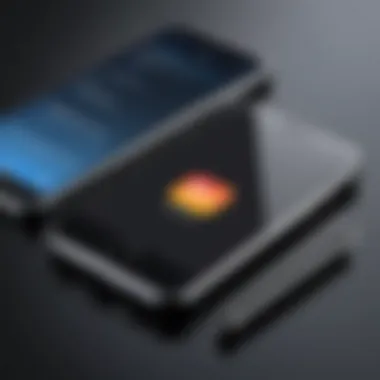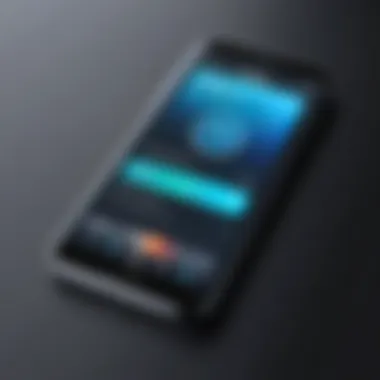How to Record Calls on iPhone for Free: A Comprehensive Guide


Intro
In a world where every conversation counts, knowing how to capture those discussions can be invaluable. Whether it's for personal records or business purposes, recording calls on your iPhone might seem complex, but it doesn't have to be. This article takes a closer look at the various methods available for iPhone users to record calls without spending a dime.
Navigating through the legal maze surrounding call recording is crucial. Depending on where you stand, certain laws apply, ranging from requiring consent from one party to needing approval from all involved in the conversation. We’ll cover this too, ensuring you’re on the right side of the law.
Besides exploring the built-in features—if any—this guide will introduce several third-party applications that can make recording calls straightforward. Alongside that, we won't ignore concerns regarding privacy and data handling, as ethical practices are equally important. Understanding these aspects will empower you to record calls efficiently and securely.
By the end, you'll not only know how to record calls but also have a well-rounded toolkit of best practices to rely on, making you a savvy user who respects both legality and privacy.
Let's dive into the core features one should consider when looking at options for call recording.
Understanding Call Recording


In today’s fast-paced, digital world, call recording has become not just a convenience but a necessity for many. This capability allows users to capture conversations for various reasons – whether to keep track of important business discussions or to remember details of a personal conversation. With the availability of numerous tools and techniques, the art of recording calls on an iPhone warrants a closer inspection. It’s paramount to understand the multiple facets of this feature to utilize it effectively while remaining within the confines of the law.
Purpose and Use Cases
Call recording serves a multitude of purposes. For professionals, retaining important calls can be invaluable for accurate record-keeping, especially in industries where details matter a great deal. Imagine a contractor discussing renovations with a client – a simple miscommunication could lead to significant repercussions. By recording such calls, they create a reference point that safeguards against potential disputes.
Similarly, journalists and content creators find this feature beneficial. Capturing interviews verbatim eliminates the stress of misquoting, ensuring that the essence of the conversation remains intact. On a more personal note, individuals may record calls with loved ones for nostalgia or simply to relive significant moments later. The versatility of call recording can, indeed, transform communication experiences across the spectrum of personal and professional engagements.
Legal Considerations
Before diving into call recording, it’s crucial to navigate the murky waters of legalities. Laws regarding this practice can vary significantly from one region to another, so users must do their homework to avoid potential legal pitfalls.
Regional Laws on Call Recording


When we talk about regional laws on call recording, it’s essential to recognize that some regions enforce strict regulations. In certain places, both parties must be notified before a call is recorded. This characteristic underscores the cultural and legal diversity surrounding communication privacy. For instance, states in the U.S. like California adhere to two-party consent laws, meaning both individuals in the conversation must consent to the recording. This situation fosters a climate of trust but can also restrict the spontaneous nature of some conversations.
Moreover, other regions may allow a single-party consent, which simplifies the process. The unique feature of such regulations is their potential to foster ambivalence among users. While flexibility often helps, it also raises awareness about compliance and responsibility. Depending on where you reside, understanding these laws can make a significant difference in determining the legality of your recording practices.
Consent Requirements
Closely related to the topic of regional laws are consent requirements. This aspect cannot be overstated, as it serves as the backbone of legal call recording. Consent requirements dictate that at least one party involved must agree to the recording. This means failing to obtain consent can result in severe implications, including potential legal action.
The key characteristic of consent requirements is their ability to protect individuals from unwanted invasions of privacy. It is a fundamental concept that reflects respect for personal boundaries. In practice, informing the other party can create open communication, and lead to more transparent conversations. However, it also poses challenges, particularly when one party is not on board with being recorded. Navigating this landscape requires sensitivity, as the unique feature of consent acts as both a safeguard and a potential barrier for users. Striking a balance between recording for various purposes and respecting privacy is vital if users want to assure themselves they are acting ethically.
As we peel back the layers of call recording, the insights gained from understanding its purpose, use cases, and legal frameworks can empower users to make informed decisions. By respecting both regional laws and consent requirements, individuals can enjoy the advantages of recording calls without stepping into legal grey areas.
Built-in Call Recording Features


In the modern landscape of communication, the ability to record phone calls can prove invaluable. For iPhone users, the native call recording features present an intriguing option. These built-in capabilities can simplify the process significantly, allowing for seamless use without the need for a plethora of third-party applications. Understanding these features is crucial, as they can provide a straightforward solution for both personal and professional needs.
Exploring iOS Capabilities
Out of the box, iOS doesn't offer direct call recording functionality. Instead, it implements alternatives that rely on conference call features. Essentially, users can initiate a three-way call where one participant is a recording line. This method, while not directly intuitive, illustrates how Apple seeks to maintain a balance between functionality and privacy.
Utilizing this method generally requires subscribing to a particular service. This is where user creativity comes into play. For example, say you need to record an important business meeting. By merging calls, you can capture the conversation. Many users find this approach can be somewhat cumbersome, as it requires meticulous planning. However, in scenarios where call recording is essential, this can be a handy feature.
Limitations of Native Options
Though native features hold their merits, it’s essential to recognize their shortcomings, hindering their effectiveness in various situations.
Availability Across Models
The availability of recording capabilities can differ across iPhone models. Newer models equipped with more advanced software might offer slightly better functionality in terms of sound quality or ease of use. However, the crux remains that this approach is not universally supported, leading to frustration among users with older devices or certain iOS versions.
Most often, users have to face the reality that the call recording options aren’t as robust as they may like. For instance, users with the iPhone SE may find that while they can merge calls to record, the audio clarity may significantly lag behind newer models. This limitation can create challenges when trying to secure clear and accessible recordings.



